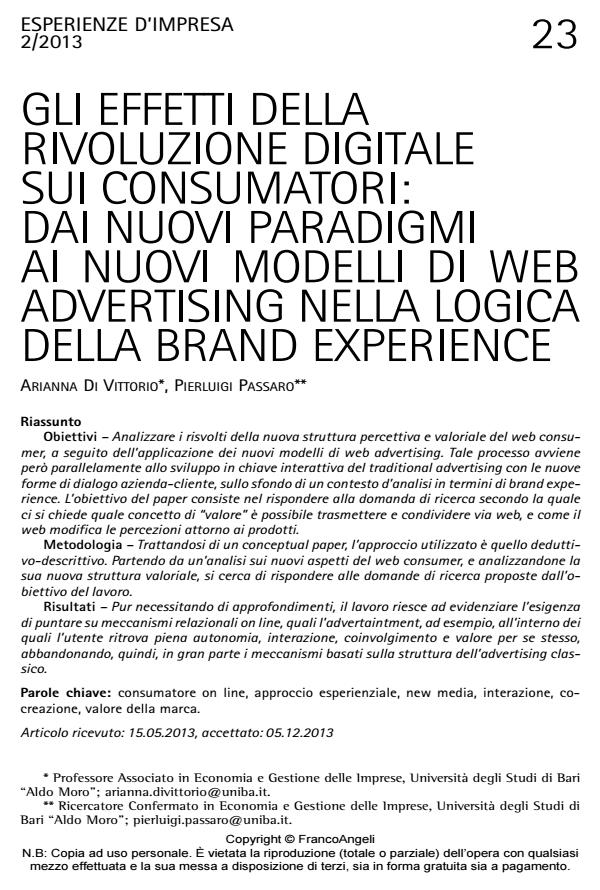Gli effetti della rivoluzione digitale sui consumatori: dai nuovi paradigmi ai nuovi modelli di web advertising nella logica della brand experience
Titolo Rivista ESPERIENZE D'IMPRESA
Autori/Curatori Arianna Di Vittorio, Pierluigi Passaro
Anno di pubblicazione 2014 Fascicolo 2013/2
Lingua Italiano Numero pagine 19 P. 23-41 Dimensione file 985 KB
DOI 10.3280/EI2013-002002
Il DOI è il codice a barre della proprietà intellettuale: per saperne di più
clicca qui
Qui sotto puoi vedere in anteprima la prima pagina di questo articolo.
Se questo articolo ti interessa, lo puoi acquistare (e scaricare in formato pdf) seguendo le facili indicazioni per acquistare il download credit. Acquista Download Credits per scaricare questo Articolo in formato PDF

FrancoAngeli è membro della Publishers International Linking Association, Inc (PILA)associazione indipendente e non profit per facilitare (attraverso i servizi tecnologici implementati da CrossRef.org) l’accesso degli studiosi ai contenuti digitali nelle pubblicazioni professionali e scientifiche
Analizzare i risvolti della nuova struttura percettiva e valoriale del web consumer, a seguito dell’applicazione dei nuovi modelli di web advertising. Tale processo avviene però parallelamente allo sviluppo in chiave interattiva del traditional advertising con le nuove forme di dialogo azienda-cliente, sullo sfondo di un contesto d’analisi in termini di brand experience. L’obiettivo del paper consiste nel rispondere alla domanda di ricerca secondo la quale ci si chiede quale concetto di "valore" è possibile trasmettere e condividere via web, e come il web modifica le percezioni attorno ai prodotti. Metodologia - Trattandosi di un conceptual paper, l’approccio utilizzato è quello deduttivo- descrittivo. Partendo da un’analisi sui nuovi aspetti del web consumer, e analizzandone la sua nuova struttura valoriale, si cerca di rispondere alle domande di ricerca proposte dall’obiettivo del lavoro. Risultati - Pur necessitando di approfondimenti, il lavoro riesce ad evidenziare l’esigenza di puntare su meccanismi relazionali on line, quali l’advertaintment, ad esempio, all’interno dei quali l’utente ritrova piena autonomia, interazione, coinvolgimento e valore per se stesso, abbandonando, quindi, in gran parte i meccanismi basati sulla struttura dell’advertising classico.
Parole chiave:Consumatore on line, approccio esperienziale, new media, interazione, cocreazione, valore della marca.
- Anderson C. (2006). The Long Tail: Why the Future of Business Is Selling Less of More. Hyperion.
- Battelle J. (2005). The Search: How Google and Its Rivals Rewrote the Rules of Business and Transformed Our Culture. Portfolio.
- Belk R.W., Wallendorf M., Sherry J.F. (1989). The sacred and the profane in Consumer Behavior: Theodicy and Odyssey. The Journal of Consumer Research, 16, 1: 1-38, DOI: 10.1086/209191
- Bennato D. (2011). Sociologia dei media digitali. Roma: Laterza.
- Denning S. (2005). The leader’s guide to storytelling: mastering the art and the discipline of business narrative. San Francisco-CA: John Wiley & Sons.
- Farber D. (2006). ETech: Attenuation, Web 2.0 and spimes. ZDNet.
- <http://blogs.zdnet.com/BTL/?p=2667>.
- Ferraresi M., Schmitt B.H. (2006). Marketing esperienziale. Come sviluppare l’esperienza di consumo. Milano: FrancoAngeli.
- Ferrari L. (2012). L’impresa nell’era della convergenza. Milano: Unicopli.
- Gates B. (2006). Microsoft MIX06 Conference Microsoft, Marzo 2006.
- Graham P. (2005). Web 2.0. <http://www.paulgraham.com/web20.html>.
- Grossman L. (2006). TIME’s Person of the Year: You. TIME <http://www.time.com/time/magazine/article/0,9171,1569514,00.html>.
- Hinchcliffe D. (2006). “The State of Web 2.0”. <http://web2.socialcomputingmagazine.com/the_state_of_web_20.htm>.
- Horrigan J. B. (2006). Home Broadband Adoption. Pew Internet & American Life Project.
- <http://www.pewinternet.org/pdfs/PIP_Broadband_trends2006.pdf>.
- Jenkins H. (2007). L’impresa nell’era della convergenza. Milano: Apogeo.
- Madden M. and Fox S. (2006). Riding the Waves of ‘Web 2.0. Pew Internet & American Life Project. <http://www.pewinternet.org/pdfs/PIP_Web_2.0.pdf>.
- Masserenti C., Mezza M. (2007), Communication Continuum. Nòva24 Review, Febbraio.
- McQuail D. (2007). Sociologia dei media. Bologna: il Mulino.
- Miller P. (2005). Thinking About This Web 2.0 Thing. <http://paulmiller.typepad.com/thinking_about_the_future/2005/08/thinking_about_.html>.
- Moore G. (1965). Cramming More Components onto Integrated Circuits. Electronics. <http://ftp://download.intel.com/museum/Moores_Law/ArticlePress_Releases/Gordon_Moore_1965_Article.pdf>.
- Musser J. and O’Reilly T. (2006). Web 2.0 Principles and Best Practices. O’Reilly Media, Inc.
- O’Reilly T. (2005). Web 2.0: Compact Definition? <http://radar.oreilly.com/archives/2005/10/web_20_compact_definition.html>.
- O’Reilly T. (2005). What is Web 2.0: Design Patterns and Business Models for the Next Generation of Software. <http://www.oreillynet.com/pub/a/oreilly/tim/news/2005/09/30/what-is-web-20.html.
- O’Reilly T. (2006). Seven principles of web 2.0 make a lot more sense if you change the order. Open Gardens.
- Pine J., Gilmore J. (2000). L’economia delle esperienze. Oltre il servizio. Milano: Hoepli.
- Prahalad C.K., Ramaswamy V. (2000). Co-Opting Customer Competence. Harvard Business Review.
Arianna Di Vittorio, Pierluigi Passaro, Gli effetti della rivoluzione digitale sui consumatori: dai nuovi paradigmi ai nuovi modelli di web advertising nella logica della brand experience in "ESPERIENZE D'IMPRESA" 2/2013, pp 23-41, DOI: 10.3280/EI2013-002002